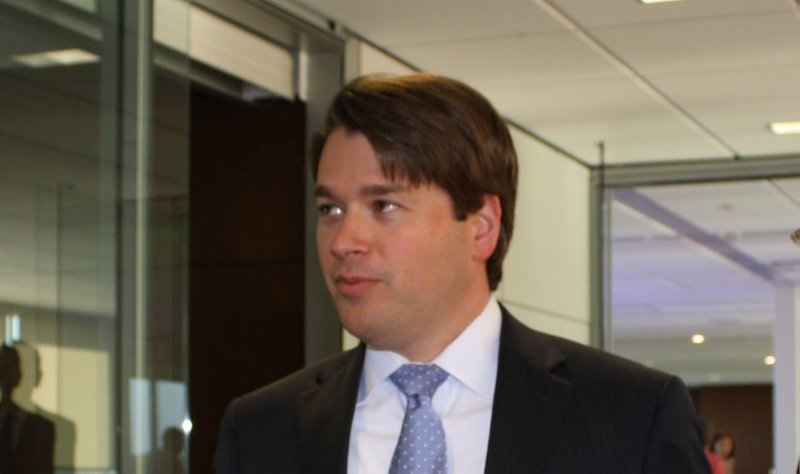The Arkansas Public Employees Retirement System's investments gained $460 million in value last quarter to reach $9.5 billion, the system's investment consultant told the system's board of trustees on Wednesday.
The system's rate of return in the quarter that ended Dec. 31 was 5.92% to rank among the top 20% of similar size public pension plans, the investment consultant Callan Inc. reported.
Since the end of the last quarter on Dec. 31, the value of the system's investments has increased to about $9.73 billion as of Wednesday, the system's chief investment officer Carlos Borromeo, said during a break in the trustees meeting.
With more than 80,000 working and retired members, the retirement system is state government's second-largest such system behind the Arkansas Teacher Retirement System. The teacher retirement system has more than 100,000 working and retired members and more than $18 billion in investments.
The Public Employees Retirement System's trustees decided to grant a 2% interest rate on deferred retirement plan balances in fiscal 2021 that starts July 1. That's "very generous in light of the current fixed income market," said Trustee Jason Brady. The one-year treasury rate is 1.47%, he noted.
In other action Wednesday, the trustees decided to interview four international stock investment managers in a future meeting. The firms are Acadian Asset Management LLC, Franklin Templeton Investments, J O Hambro Capital Management, and Lizard Asset Management. The trustees will decide which one or two firms to hire to manage $330 million in international stock markets.
The trustees also learned that the system recently settled for $65 million a class-action securities lawsuit in which it is the lead plaintiff. The class-action lawsuit is Baker vs. Seaworld Entertainment Inc., and the system was represented by the Kessler, Topaz, Meltzer & Check, and the Nix, Patterson & Roach law firms, according a system report. The system's chief legal counsel, Laura Gilson, said how much the system will receive under this settlement hasn't been determined.
In the quarter that ended June 30, the system's domestic stock market investments increased in value by $216 million, to $3.84 billion, as they posted an investment return of 7.59%, while the system's international stock market investments increased in value by $214 million, to $2.38 billion, with a return of 9.94%, Callan Inc. reported Wednesday.
The system's bond investments increased in value by $7 million last quarter to $1.49 billion with an investment return of 0.58%, while the system's "real asset" investments such as global energy, real estate and timber investments increased in value by $10 million, to $1.34 billion, with a return of 1.84%, according to Callan Inc.
The system's investments in diversified strategies increased in value by $12 million last quarter to $469 million with an investment return of 2.83%, Callan reported.
In calendar year 2019, the system's investment return was 20.9% to rank in the top 12% of similar size public pension plans, said Brianne Weymouth of Callan Inc.
"You have outperformed 88% of other public funds over the last year," she told the system's board of trustees.
"Because of the higher allocation that you had to equities versus some of your peers ... the fund is outperforming the median" for public pension funds over longer time periods, Weymouth said.
The system's average investment return over the past five years is 7.6% a year to rank in the top 30% of public pension plans, and the system's average return over the past 10 years is 9.18% to rank in the top 17% of public pension plans, according to Callan's report. The system's average return over the past 20 years is 6.31% a year to rank among the top 33% of public pension plans.
"These numbers are looking super," said Trustee Daryl Bassett.
The system's target investment return is now 7.15% a year.
As of June 30, the system had 45,965 working members with an average salary of $39,212 a year and 38,543 retirees and beneficiaries with annual retirement benefits of $609.1 million (or an average of $15,803 a year), according to system actuary Gabriel, Roeder, Smith & Co.
The system was 78.5% funded as of June 30 with an actuarial value of assets at $8.7 billion and total liabilities of $11.1 billion, the actuary reported in November.
The system's projected payoff period for its unfunded liabilities was 24 years as of June 30, Gabriel reported. Actuaries often compare unfunded liabilities to a mortgage on a home.
A goal of the trustees is to reduce the system's unfunded liabilities, but most of the bills they proposed for the 2019 regular session to do that failed to clear the Joint Committee on Public Retirement and Social Security Programs.
In November, the system's trustees voted to keep the current contribution rate charged to state and local governments at 15.32% for fiscal 2022, which starts July 1, 2021. State and local governments paid $293.5 million into the system in fiscal 2019 that ended June 30, while member employees paid $68.2 million, according to a system report. Most members pay 5% of their salary into the system.
With the legislative retirement committee planning to hold public hearings this fall across the state about proposed legislation, system Executive Director Duncan Baird said Wednesday that the committee's leaders are going to rely on the board of trustees for specific recommendations.
Since the recession in 2008 and 2009, the system has relied on increases in the rate charged to state and local governments -- but not any increases in the rate charged to working members or reductions in retirement benefits -- to improve its financial plight, said Mita Drazilov of Gabriel, Roeder, Smith & Co.
"That's quite uncommon in the country," because most public pension systems used a combination of increases in the rates charged to both employers and employees and cuts in retirement benefits to improve their finances since the recession, Drazilov said.
Metro on 02/20/2020
CORRECTION: The one-year treasury rate is 1.47%. An earlier version of this story listed an incorrect figure.
